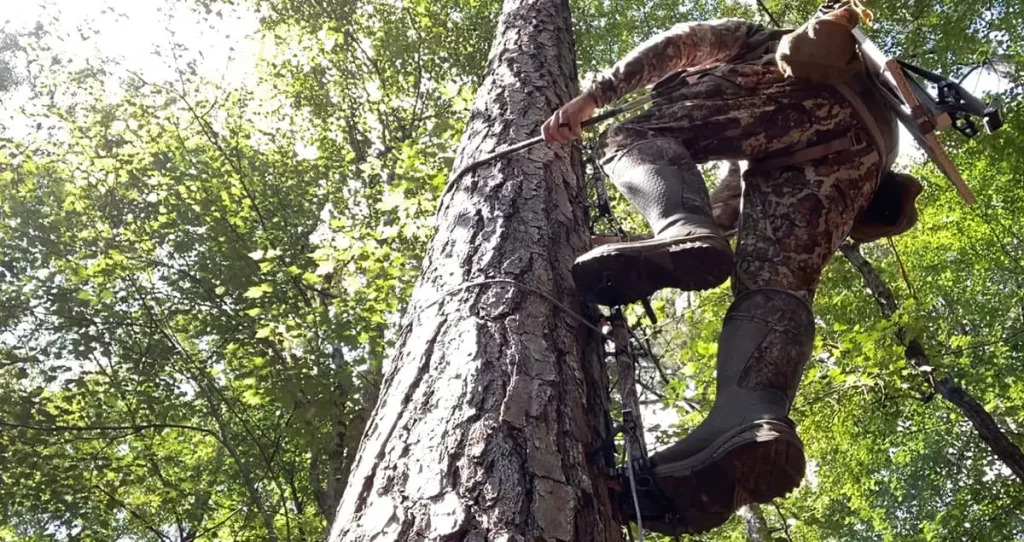6 Climbing Methods for Saddle Hunting: From Easy to Extreme
One of the key aspects of saddle hunting is the climbing method used to get up in the tree. There are quite a few ways to get that done, but most hunters use variations of one of these three:
- Climbing Sticks — Portable, lightweight ladders placed against tree
- Screw-In/Strap-On Steps — Individual steps screwed or strapped onto tree
- Climbing Spurs — Boot spikes that allow climbing by digging into bark
Below we’ll discuss each method, including the pros and cons, safety considerations, and tips for proper use.
Climbing Sticks

Climbing sticks are by far the most popular climbing method because they are easy to use and readily availble. They also don’t damage the tree, which ensures they are legal about anywhere you want to hunt.
Sticks come in a variety of lengths and materials, and at a broad price spectrum. Typically the lighter and more compact the sticks, the more you’re going to pay.
Cost
Expect to pay anywhere from just under $100 to well over $400 for three to four climbing sticks depending on the brand, materials used, and portability. How many climbing sticks you ultimately need will depend on how high off the ground you prefer to hunt, but three to four seem to be the average. You can always add aiders to gain additional height.
Advantages
- Easy to setup and use
- Allow quiet climbing
- Don’t damage trees like screw-in steps or spurs
- Works on a variety of tree sizes and shapes
Disadvantages
- Can be bulky and heavy, depending on model
- Limited climbing height based on number of sticks
- Can be noisy during the handling and setup process
One-Stick Method
I won’t go into too much detail on this, because I have a whole article on “one sticking”, but if you really want to go lightweight, this may be a method worth considering. By using a much longer tether rope (typically 30ft) and a rappelling device, you can climb a tree using only one climbing stick, then rappel down after the hunt.
It sounds a little crazy and over-the-top, but it’s not as difficult as it sounds. And it certainly will lighten your pack. Some hunters enjoy it and find it worth the weight savings, while others would rather carry a little extra weight. I’m in the latter group.
My Tethrd One sticks only weight 1lb each, so I would only save a few pounds using the one-stick method. To me, that’s not enough weight savings to warrant the extra effort.
Screw-In or Strap-On Steps
Before there were climbing sticks, screw-in steps were the climbing method of choice. They are compact and get the job done, but have their disadvantages. Since most are made of steel, they can be heavy by the time you pack in enough to get to hunting height.
It’s also labor intensive to screw a bunch of steps into a tree, especially a hardwood tree. There are tools to make the job easier, but then you’re adding even more weight to your pack.
Then there is the biggest issue, which is they are often not legal to use on public lands. That varies by state, but many prohibit anything that damages the tree.
If you have private land, and you tend to hunt from the same trees, then placing screw-in steps in those trees for the season can be a good idea. Then you can slip in, without the extra weight, and climb the tree quietly and with minimal effort.
I would not recommend leaving them in the trees permanently, however, because the tree will eventually grow around them, and they can create a serious hazard for future logging operations in the area. So if you’re going to use screw-in steps on your property, take them down after the season and allow the tree to heal.
An alternative to screw-in steps are their strap-on counterparts. These eliminate the legal issues on public lands and they’re not as labor intensive to install. But in my opinion, they aren’t as rock solid as a screw-in step. And you still have to pack in quite a few steps and straps to get to a decent hunting height.
Cost
Expect to pay between $3 and $5+ dollars per step, and you’ll probably want between 8 and 12 steps.
Advantages
- Don’t need to carry steps in/out each hunt
- Safer than portable climbing sticks
- Allow quiet access to stand
- Provide permanent access to your tree stand location
Disadvantages
- Damage tree over time when drilling into bark
- Screws can come loose or break over time
- Straps may loosen or slip over time
- Take more prep work to install
Tips for Use
- Use thick-barked trees that can better withstand screws\
- Alternate side of tree with each step
- Use a tree step tool to make installation easier
- Check strap tightness regularly and remove during growth seasons
- Inspect steps before each climb for stability
Climbing Spurs
If you aren’t familiar with climbing spurs, they are metal spikes that strap onto your hunting boots through a harness. The spikes dig into the tree bark, allowing the hunter to climb up the tree by alternating kicks. It’s the same method arborists use to climb trees, and lineman use to climb wood utility poles.
They are by far the least common of the three climbing methods discussed in this article, but still worth discussing. Since you only have to pack in the pair of spurs, they are relatively lightweight and compact. And you can climb to any height needed.
Obviously, this method has the biggest learning curve and is probably the most dangerous. It’s not a method I’d recommend unless you have experience and are very comfortable using them.
Like screw-in steps, some states may prohibit climbing spurs on public lands due to the potential damage they can do to a tree.
Cost
The cost of climbing spurs varies widely from $60 to well over $300 depending on the quality of the product.
Advantages
- Allow quick, hands-free climbing
- Very lightweight and easy to carry
- Fast to put on boots and start climbing
Disadvantages
- Steeper learning curve than other methods
- Spurs can damage and tear up tree bark
- Noisy when climbing
- Unsafe for trees with loose, slippery bark
- May not be legal in some areas due to tree damage
More ‘Extreme’ Methods
Saddle hunters are a resourceful group! Taking notes from professional arborists and recreational tree climbers (yeah, it’s a thing!), they have developed several outside-the-box methods of climbing that eliminate the need for sticks, steps or spurs altogether.
I’ve labeled these ‘extreme’ because they certainly appear that way at first glance. They are actually pretty innovative, but you’ll have to decide if they’re worth the meager weight savings.
I haven’t personally used either of these methods, and will just briefly touch on each. I’ve included a video if you want to see them in use. If one of these interest you, I would highly recommend getting with someone experienced in SRT or DRT to learn in a safe, controlled setting.
SRT Method
The SRT, or single rope technique, involves using a long tether rope that you pull up into a tree using a smaller paracord rope with a weight on one end. Once you have your tether rope secured above hunting height in the tree, you use a hand ascender with an aider and rappel device to climb the rope up to hunting height.
That probably sounds really confusing, which is why I included the video below. It’s something you really need to watch to get a feel for. The SRT method is less labor intensive than the DRT method discussed below, but requires more gear (which means more weight).
In addition to your standard saddle hunting equipment, you’ll need:
- Hand ascender
- Multi-step aider
- Rappel device
- Some paracord with a weighted ball tied on the end
DRT Method
DRT stands for Double Rope Technique. It shares some similarities to the SRT method, mainly in the way you use a small paracord rope to pull your long tether rope up into the tree. That’s where the similarities end.
Rather than cinching your tether rope up in the tree, you run one end through a carabiner hooked to the bridge rope of your tether, tie it to the carabiner, then take that same end of rope and tie a blake hitch onto the other half of the rope that is dangling from the tree.
You then position your feet on the tree, suspended in a mostly horizontal position, and thrust your hips forward as you pull the slack out of the rope through the Blake hitch. Then you move your feet up the tree a little and repeat the process. You’re essentially ‘walking’ up the tree.
As I mentioned above, this is a little more labor intensive, but the tradeoff is not needing a hand ascender or rappelling device. Check out the video below to get a much better idea of how the DRT method works.
Choosing the Right Climbing Method
When selecting a climbing method, consider these key factors:
Elevation Needed – The higher you like to hunt, the more climbing sticks or steps you’re going to need. Climbing spurs eliminate that need, but require expertise and come with risks. The one-stick climbing method is also an option.
Portability – Spurs and sticks are lightweight and fast to set up. This makes them ideal if you’re hunting multiple locations. Steps keep you from hauling gear once installed.
Regulations – As mentioned, spurs and screw-in steps may not be legal on public land in some areas. Make sure your methods are legal.
Budget – While steps are the cheapest option, they may not be the best for your circumstances. There are lots of climbing sticks at a variety of price points for most any budget. Quality climbing spurs are similar in price to quality climbing sticks.
As you can see, there are several factors to weigh when selecting the best saddle hunting climbing method for your needs and preferences. Consider your tree availability, hunting locations, time investment, and skills to decide between sticks, steps, or spurs. Mixing methods like installing a couple steps with sticks may also be an option.
Final Thoughts
Having the right climbing gear and techniques makes accessing your saddle hunting location safer and easier. There are pros and cons to each of the three most popular methods.
Keep safety as your top priority by always using a harness with lineman’s belt for fall protection. Inspect tree bark and health before climbing. And always check regulations in your state regarding climbing methods.
With practice, you’ll gain efficiency and confidence climbing with your preferred method. That allows you to focus on the enjoyable saddle hunt itself rather than worrying about climbing with unstable or inadequate gear. Take your time, follow safe practices, and enjoy the view from above when saddle hunting this season.
